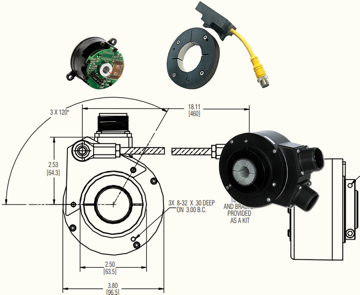Hollowshaft encoders allow the motor shaft to pass completely through and are secured by a shaft collar. This mounting style is easier to install and requires less space than a shafted encoder. Flexibility from the tether allows the encoder to float with the movement of the motor shaft, alleviating wear and tear on the bearings. The shaft collar is electrically isolated from the motor for protection against stray motor current.
What is a Hollowshaft Encoder?
Posted by London Rhodes on Jan 19, 2022 8:29:55 AM
What are the Encoder Mounting Options?
Posted by London Rhodes on Jan 19, 2022 8:14:21 AM
There are several types of encoder mounting styles to choose from when selecting an encoder for your application. Typically, you will choose between hollowshaft, shafted, hubshaft, and ring (or c-faced) mounting styles for encoders. Hollowshaft encoders allow the shaft of the motor to go through the encoder, and secures to the shaft by the shaft collar. Shafted encoders attach to the motor with a flexible coupling or possibly a belt (gear). Hubshaft encoders mount to motor shafts similarly to hollowshaft encoders. The difference in the hubshaft is that the motor shaft can only go about halfway into the encoder rather than completely through. Lastly, the ring (c-faced) option allows the encoder to bolt directly to the flange of the motor for bearingless designs. You will need to choose the mounting style that best suits your motor or application.
Topics: How to Choose An Encoder, Installation, Absolute Encoders, Optical Encoders, Magnetic Encoders
How Do I Use an Encoder and Measuring Wheel on a Conveyor System?
Posted by London Rhodes on Sep 29, 2021 8:53:21 AM
Dynapar offers a three piece solution for conveyor systems including an encoder, measuring wheel and bracket. A few brackets are specifically designed for use on a conveyor.
Topics: How to Choose An Encoder, Installation, Absolute Encoders
What is an Encoder Tether?
Posted by London Rhodes on Aug 27, 2021 1:59:00 PM
A tether is an anti rotation device mounted between motor and encoder to ensure the encoder remains stationary while the motor is running.
Topics: Installation, Absolute Encoders, Troubleshooting
How Many Shaft Positions Exist on Absolute Encoders?
Posted by London Rhodes on Jul 29, 2021 10:33:47 AM
You can calculate the number of shaft positions on your encoder with the following equation: 2x where X = the resolution of your absolute encoder in bits.
Topics: Installation, Absolute Encoders, Encoder Signals Output, Troubleshooting
What is the Advantage of Absolute Encoders?
Posted by London Rhodes on Jun 18, 2021 11:15:25 AM
An absolute encoder has each position of the revolution uniquely numbered. This means that instead of an output of pulses, you get an output that is a specific value in a binary format. This is very useful when exact positioning is a must. Since each location in an absolute encoder's revolution is a unique binary value, if the power should be lost, the actual value of the position will be known when power is restored. The exact position will be known even if the controller loses power and the process is moved.
How Quickly Can Your Absolute Encoder Report its Position?
Posted by London Rhodes on Feb 16, 2021 7:16:00 PM
Absolute encoders operate on a question-answer system, completely different from incremental encoders. During the operation of an absolute encoder, an outside controller locates the encoder position. The encoder sends the controller its ID codes, data bits, and end bits. Each step in the process takes time and varies from model to model and manufacturer to manufacturer. The differing data protocols allow users to set various bit rates (Baud), types of error codes, and data styles.
Topics: Absolute Encoders
